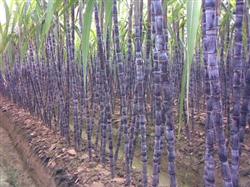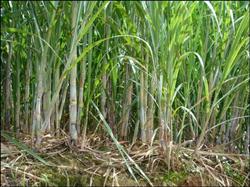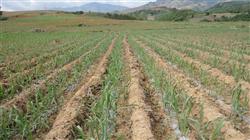Cultivation techniques of Fruit Sugarcane

1. Variety selection at present, there are two kinds of fruit sugarcane planted in Yuanjiang County: crisp red sugarcane and magenta sugarcane. According to the results of the comparison test conducted in Daming Nunnery in 2000, crisp red sugarcane is obviously better than magenta sugarcane in stem diameter, stem weight, Internode length, silty quality and stomachability, or in per unit yield and commodity rate. When selecting seeds, the sugarcane should be thick, uniform and crack-free, with thick shoots, broad green leaves, disease-free and insect-free shoots, and should not be selected. 2. land selection and land preparation 1. Land selection is below 700 meters above sea level, with deep soil layer, fertile soil, loose texture, good drainage and irrigation, convenient transportation and sufficient sunshine, which requires a rotation of 2-3 years. 2. After soil preparation and soil moisture continuous cropping, the residue should be burned in time after harvest. At the same time, the field should be flooded for more than a week to eliminate the residue and pests in the soil. After the water is dry, the depth should be more than 30 cm. The rotation land should also be ploughed after the surface residue is removed. The soil should be raked to pieces before moisture management. the planting ditch should be 120 cm apart, the ditch depth is more than 40 cm, and the bottom width is 20 cm. Third, the planting time of fruit sugarcane is from September of that year to February of the next year, and there is no sugarcane seed too early, which affects the yield and quality too late. Before planting, combined with the pine ditch bottom, the bottom fertilizer should be applied to the ditch bottom, and the amount of base fertilizer should not be less than 1000 kg of farm manure per mu and 50 kg of rare earth superphosphate (or common calcium, calcium magnesium phosphorus). After applying the base fertilizer, the planting density is generally controlled at about 20 buds per meter, ensuring that the effective stem per mu is not less than 4500. 4. Mid-tillage management: 1. Fertilization: ① seedling fertilizer: after emergence, combined with the first weeding, 15 kg urea per mu. Fertilization during ② growth period: the soil was cultivated every time during the field growth period, 100kg rare earth superphosphate (or calcium superphosphate, calcium magnesium phosphorus), 10kg nitrogen, phosphorus and potassium compound fertilizer (or potassium chloride) and 10kg silicon-calcium fertilizer were applied per mu. Foliar fertilizer and balance fertilizer were applied to ③ at the right time. During the growing period, according to the seedling condition, the compound, efficient, pluralistic, organic ecological foliar fertilizer "Rong Dafeng" 300 times liquid was sprayed for 3 times for 4 times. After setting the seedlings (8 plants per meter), the weak seedlings were frequently irrigated with 5% ammonium carbonate water on the roots. 2. rational irrigation of fruit and sugarcane requires a large amount of water, so we should pay attention to timely irrigation, but we should avoid flood irrigation, advocate light water irrigation, and keep the soil dry and wet, mainly moist. 3. Generally, the seedlings should be cultivated 4 times a year with an interval of about 30 days, and the seedlings should be fixed at the right time. 4. The leaf-stripping sugarcane plant began to peel leaves after elongation, with 4 leaves per peeling, too much leaf peeling affected the plant growth, and leaf peeling did not affect the pollination in time. 5. Prevention and control of diseases, insects, weeds and rodents. In Yuanjiang County, due to the early planting age, long continuous cropping period, and not paying attention to unified control, the accumulated base of diseases and insect pests is getting larger and larger, resulting in the occurrence of all kinds of diseases and insect pests. Therefore, the prevention and control of diseases, insect pests, weeds and rodents should be strengthened. The main diseases of fruit sugarcane are pineapple disease, tip rot, smut and leaf wilt, and the main pests are sugarcane borer (commonly known as sugarcane core worm) and woolly aphid, pink scale, sugarcane turtle and so on. In the control strategy, the comprehensive control measures of "agricultural control, biological control, physical control and chemical control" should be taken. (1) Agricultural prevention and control: the main measures for agricultural prevention and control are rational distribution and regular rotation, standardized planting, selection of disease-free seedlings, cleaning the countryside, strengthening field management, and disinfecting seedlings with 3% raw lime water for 6 hours when sowing, so as to promote the healthy growth of sugarcane plants, enhance resistance and inhibit the occurrence of diseases and insect pests. (2) Biological control: biological control is the use of natural enemies of pests such as Trichogramma, red ants, ladybugs, mantis and dragonflies to control the occurrence and development of insect pests. According to the common characteristics of poor resistance of pests and beneficial insects to pesticides with high toxicity and high residues, biological pesticides with low toxicity and low residues should be promoted to avoid or reduce the damage to the natural enemies of insect pests. (3) physical control: physical control mainly makes use of the phototaxis of adults and traps and kills adults by setting light waves. At present, the trapping effect of "Jiaduo brand frequency vibrating insecticidal lamp" is ideal. Under normal weather conditions, when the light is turned on for 10 hours every night, each lamp can trap and kill 300 cane borer adults, 200 cane tortoises and many other pests. Generally, one is installed for every 50 Mu or so of sugarcane fields, and the lamp rack is about 20 centimeters higher than the crop and can be raised and lowered. (4) Chemical control: even if pesticides are used in chemical control, in order to achieve rapid and efficient control effect, we must seize the peak period (that is, three peaks from March to April, June to July, and September to October). To achieve the four unity of "unified medicine, unified time, unified action, unified application". 1. Sugarcane borer control: (1) when planting, 5 kg of ground insecticidal or 5 kg of ground insecticidal or 5 kg of Milol granule mixed with base fertilizer were applied into the sowing ditch, and then planted and covered with soil, and then combined with each soil cultivation, the same amount of soil was mixed with fertilizer. (2) when a small amount of withered heart seedlings appeared in the seedling stage, a knife was used to pry off the roots and burn them. When a small amount of stem decay was found in the middle and later stage, a sharp knife was used to pierce the borer hole to kill the larvae or the syringe was directly injected into the insect track. (3) large area spray. If you want to select the right medicament, you must pay attention to the mixture of long-acting pesticides and quick-acting pesticides. The amount of water used per mu is 45ml 90kg, mainly sprayed on the heart leaf, leaf sheath and wormhole. The recommended pesticide varieties are 1000 times of 5% fipronil or 98% of Batan powder or 1000 times of 10% fenitrothion, etc., used alternately, properly mixed with kung fu, Nongdi Le, Baishu, Didijing, aphid borer, quick culling, phoxim and so on. 2. Control of woolly aphid, red pink aphid and sugarcane turtle: generally, they can be treated at the same time when controlling sugarcane borer, but if missed treatment, special pesticides should be used to treat them. Woolly aphids use 25% aldicarb 2000 times or 10% imidacloprid 2500 times; pink aphids kill 1500 times or 40% poisonous ticks with 40% speed; sugarcane turtles use 70% sulfuric acid 800 times or 24% Wanling 600 times. 3. Disease control: spray with 75% chlorothalonil 500 times or 70% methyl topiramate 800 times or 50% carbendazim 1000 times or 70% Dysen zinc 500 times continuously for more than 4 times with an interval of 7 mi for 10 days. It can be sprayed with insecticides. 4. grass damage control: spray the surface with 50% du A mixture 300 times or Xuanhua Yi 300 times at the seedling stage, irrigate water before emergence after planting, and spray 150 times with 10% glyphosate after the moisture is slightly dry. Choose to spray when there is no wind on a sunny day. Add appropriate amount of neutral washing powder to glyphosate to make the lotion adhere to the grass leaves, pay attention to the spray quality, spray head cover safety shield, do not spray on crops. 5. Prevention and control of rodent damage: poison grain with 7/10000 diphacinone sodium salt, prohibit rat poison sold on the street, and reduce environmental pollution and human and animal toxicity. Sixth, harvest at the right time. The whole growth period of sugarcane is about 260 days, that is, it takes more than 260 days after emergence to achieve full maturity, the highest yield and the best quality, otherwise too early and too late will affect the yield and quality. Burn the residue and flood the field for more than a week at the same time, eliminate the residue and pests in the soil, wait for the water to dry before ploughing, the depth should be more than 30 centimeters; the rotation land should also remove the surface residue before ploughing. The soil should be raked to pieces before moisture management. the planting ditch should be 120 cm apart, the ditch depth is more than 40 cm, and the bottom width is 20 cm. Third, the planting time of fruit sugarcane is from September of that year to February of the next year, and there is no sugarcane seed too early, which affects the yield and quality too late. Before planting, combined with the pine ditch bottom, the bottom fertilizer should be applied to the ditch bottom, and the amount of base fertilizer should not be less than 1000 kg of farm manure per mu and 50 kg of rare earth superphosphate (or common calcium, calcium magnesium phosphorus). After applying the base fertilizer, the planting density is generally controlled at about 20 buds per meter, ensuring that the effective stem per mu is not less than 4500. 4. Mid-tillage management: 1. Fertilization: ① seedling fertilizer: after emergence, combined with the first weeding, 15 kg urea per mu. Fertilization during ② growth period: the soil was cultivated every time during the field growth period, 100kg rare earth superphosphate (or calcium superphosphate, calcium magnesium phosphorus), 10kg nitrogen, phosphorus and potassium compound fertilizer (or potassium chloride) and 10kg silicon-calcium fertilizer were applied per mu. Foliar fertilizer and balance fertilizer were applied to ③ at the right time. During the growing period, according to the seedling condition, the compound, efficient, pluralistic, organic ecological foliar fertilizer "Rong Dafeng" 300 times liquid was sprayed for 3 times for 4 times. After setting the seedlings (8 plants per meter), the weak seedlings were frequently irrigated with 5% ammonium carbonate water on the roots. 2. rational irrigation of fruit and sugarcane requires a large amount of water, so we should pay attention to timely irrigation, but we should avoid flood irrigation, advocate light water irrigation, and keep the soil dry and wet, mainly moist. 3. Generally, the seedlings should be cultivated 4 times a year with an interval of about 30 days, and the seedlings should be fixed at the right time. 4. The leaf-stripping sugarcane plant began to peel leaves after elongation, with 4 leaves per peeling. Too much leaf peeling affected the plant growth, and leaf peeling did not affect the pollination in time.
- Prev

Scientific fertilization Technology for planting Sugarcane
The average elongation of sugarcane is more than 3 cm per ten days from the beginning of jointing and the average elongation of sugarcane is more than 3 cm per ten days. It is also the golden season of sugarcane jointing, and good field management is the key to a bumper harvest. Therefore, we must pay attention to the following measures: first, re-application of stem fertilizer sugarcane extension is to expand the root, open big.
- Next

How to cultivate sugarcane seedlings?
1 cultivation technique of plastic film mulching of newly planted sugarcane 1.1 Fine soil preparation with cattle plough or tractor ploughing 25mur30cm to achieve two ploughs and two rakes. Then press the row spacing of 90ml / 100cm to plough or artificially plant the sugarcane ditch with a depth of 23mm / 25cm. At the same time, in order to prevent rain and stagnant water in the future, drains and ditches should be opened around the sugarcane fields.
Related
- Moge, come on! The staff of the peasant association in the producing area of cantaloupe were frightened when the crowd gathered.
- Causes and Solutions of low Fruit setting rate of Apple
- Symptoms and control measures of passion fruit virus disease
- Fruit growing lesson: how do apple orchards keep high yields?
- Can you build orchards in the mountains? What are the pros and cons?
- How to manage the coloring period of Crisson grape?
- This paper introduces the processing technology of two kinds of fig products.
- How much is a month for retired teachers in rural areas by 2020?
- How can strawberry planting increase sugar content? We should pay attention to management in many aspects.
- What are the cultivation techniques on how to improve the yield of golden fruit?

